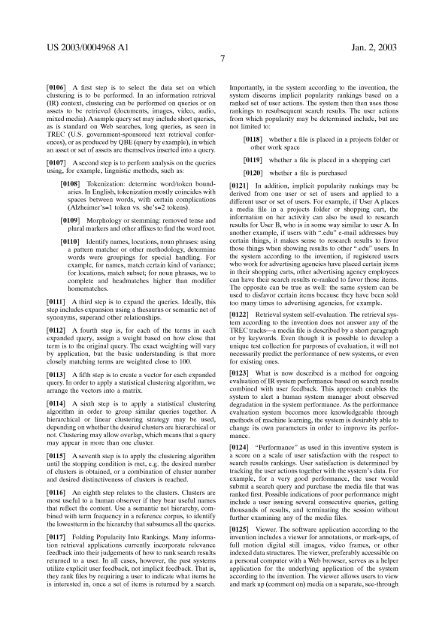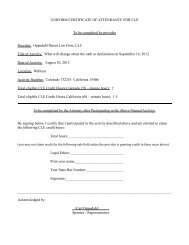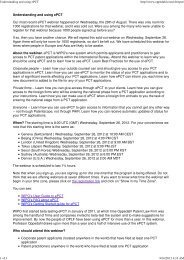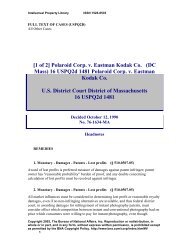Patent Application Publication (10) pub. NO.: US 2003/0004968 A1
Patent Application Publication (10) pub. NO.: US 2003/0004968 A1
Patent Application Publication (10) pub. NO.: US 2003/0004968 A1
You also want an ePaper? Increase the reach of your titles
YUMPU automatically turns print PDFs into web optimized ePapers that Google loves.
Jan. 2,<strong>2003</strong><br />
[0<strong>10</strong>6] A first step is to select the data set on which Importantly, in the system according to the invention, the<br />
clustering is to be performed. In an information retrieval system discerns implicit popularity rankings based on a<br />
(IR) context, clustering can be performed on queries or on ranked set of user actions. The system then then uses those<br />
assets to be retrieved (documents, images, video, audio, rankings to resubsequent search results. The user actions<br />
mixed media). Asample query set may include short queries, from which popularity may be determined include, but are<br />
as is standard on Web searches, long queries, as seen in not limited to:<br />
TREC (U.S. government-sponsored iexi retrieval conferences),<br />
or as produced by QBE (query by example), in which [0118] whether a file is placed in a projects folder or<br />
an asset or set of assets are themselves inserted into a query. other work space<br />
[0<strong>10</strong>7] A second step is to perform analysis on the queries<br />
using, for example, linguistic methods, such as:<br />
[0119] whether a file is placed in a shopping cart<br />
[0120] whether a file is purchased<br />
[0<strong>10</strong>8] Tokenization: determine wordltoken boundaries.<br />
In English, tokenization mostly coincides with<br />
spaces between words, with certain complications<br />
(AlzheimerYs=l token vs. sheYs=2 tokens).<br />
[0<strong>10</strong>9] Morphology or stemming: removed tense and<br />
plural markers and other affixes to find the word root.<br />
[01<strong>10</strong>] Identify names, locations, noun phrases: using<br />
a pattern matcher or other methodology, determine<br />
words were groupings for special handling. For<br />
example, for names, match certain kind of variance;<br />
for locations, match subset; for noun phrases, we to<br />
complete and headmatches higher than modifier<br />
homematches.<br />
[Olll] A third step is to expand the queries. Ideally, this<br />
step includes expansion using a thesaurus or semantic net of<br />
synonyms, superand other relationships.<br />
[0112] A fourth step is, for each of the terms in each<br />
expanded query, assign a weight based on how close that<br />
term is to the original query. The exact weighting will vary<br />
by application, but the basic understanding is that more<br />
closely matching terms are weighted close to <strong>10</strong>0.<br />
[0113] A fifth step is to create a vector for each expanded<br />
query. In order to apply a statistical clustering algorithm, we<br />
arrange the vectors into a matrix.<br />
[0114] A sixth step is to apply a statistical clustering<br />
algorithm in order to group similar queries together. A<br />
hierarchical or linear clustering strategy may be used,<br />
depending on whether the desired clusters are hierarchical or<br />
not. Clustering may allow overlap, which means that a query<br />
may appear in more than one cluster.<br />
[0115] A seventh step is to apply the clustering algorithm<br />
until the stopping condition is met, e.g. the desired number<br />
of clusters is obtained, or a combination of cluster number<br />
and desired distinctiveness of clusters is reached.<br />
[0116] An eighth step relates to the clusters. Clusters are<br />
most useful to a human observer if they bear useful names<br />
that reflect the content. Use a semantic net hierarchy, combined<br />
with term frequency in a reference corpus, to identify<br />
the lowestterm in the hierarchy that subsumes all the queries.<br />
[0117] Folding Popularity Into Rankings. Many information<br />
retrieval applications currently incorporate relevance<br />
feedback into their judgements of how to rank search results<br />
returned to a user. In all cases, however, the past systems<br />
utilize explicit user feedback, not implicit feedback. That is,<br />
they rank files by requiring a user to indicate what items he<br />
is interested in, once a set of items is returned by a search.<br />
[0121] In addition, implicit popularity rankings may be<br />
derived from one user or set of users and applied to a<br />
different user or set of users. For example, if User A places<br />
a media file in a projects folder or shopping cart, the<br />
information on her activity can also be used to research<br />
results for User B, who is in some way similar to user A. In<br />
another example, if users with ".eduW e-mail addresses buy<br />
certain things, it makes sense to research results to favor<br />
those things when showing results to other ".edun users. In<br />
the system according to the invention, if registered users<br />
who work for advertising agencies have placed certain items<br />
in their shopping carts, other advertising agency employees<br />
can have their search results re-ranked to favor those items.<br />
The opposite can be true as well: the same system can be<br />
used to disfavor certain items because they have been sold<br />
too many times to advertising agencies, for example.<br />
[0122] Retrieval system self-evaluation. The retrieval system<br />
according to the invention does not answer any of the<br />
TREC tracks-a media file is described by a short paragraph<br />
or by keywords. Even though it is possible to develop a<br />
unique test collection for purposes of evaluation, it will not<br />
necessarily predict the performance of new systems, or even<br />
for existing ones.<br />
[0123] What is now described is a method for ongoing<br />
evaluation of IR system performance based on search results<br />
combined with user feedback. This approach enables the<br />
system to alert a human system manager about observed<br />
degradation in the system performance. As the performance<br />
evaluation system becomes more knowledgeable through<br />
methods of machine learning, the system is desirably able to<br />
change its own parameters in order to improve its performance.<br />
[0124] "Performance" as used in this inventive system is<br />
a score on a scale of user satisfaction with the respect to<br />
search results rankings. User satisfaction is determined by<br />
tracking the user actions together with the system's data. For<br />
example, for a very good performance, the user would<br />
submit a search query and purchase the media file that was<br />
ranked first. Possible indications of poor performance might<br />
include a user issuing several consecutive queries, getting<br />
thousands of results, and terminating the session without<br />
further examining any of the media files.<br />
[0125] Viewer. The software application according to the<br />
invention includes a viewer for annotations, or mark-ups, of<br />
full motion digital still images, video frames, or other<br />
indexed data structures. The viewer, preferably accessible on<br />
a personal computer with a Web browser, serves as a helper<br />
application for the underlying application of the system<br />
according to the invention. The viewer allows users to view<br />
and mark up (comment on) media on a separate, see-through





